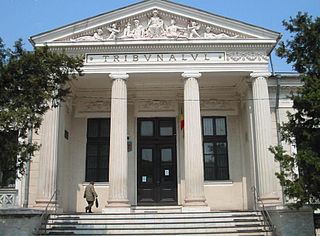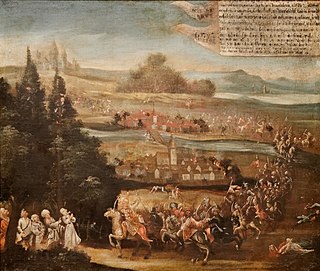Battle of Giurgiu may refer to:
- Battle of Giurgiu (1595), during the Long Turkish War
- Battle of Giurgiu (1771), during the Russo-Turkish War of 1768–1774
Battle of Giurgiu may refer to:

Giurgiu is a city in southern Romania. The seat of Giurgiu County, it lies in the historical region of Muntenia. It is situated amongst mud-flats and marshes on the left bank of the Danube facing the Bulgarian city of Ruse on the opposite bank. It is one of six Romanian county seats lying on the Danube river. Three small islands face the city, and a larger one shelters its port, Smarda. The rich grain-growing land to the north is traversed by a railway to Bucharest, the first line opened in Romania, which was built in 1869 and afterwards extended to Smarda. In the past, Giurgiu exported timber, grain, salt and petroleum, and imported coal, iron, and textiles.

Oltenița is a city in Călărași County, Muntenia, Romania, on the left bank of the river Argeș, where its waters flow into the Danube.

Turnu Măgurele is a city in Teleorman County, Romania, in the historical region of Muntenia. Developed nearby the site once occupied by the medieval port of Turnu, it is situated north-east of the confluence between the Olt River and the Danube, at the edge of the Wallachian Plain.
Battle of the Dardanelles may refer to:

Akinji or akindji were irregular light cavalry, scout divisions (deli) and advance troops of the Ottoman Empire's military. When the pre-existing Turkish ghazis were incorporated into the Ottoman Empire's military they became known as "akıncı." Unpaid, they lived and operated as raiders on the frontiers of the Ottoman Empire, subsisting on plunder. In German sources these troops were called Renner und Brenner. There is a distinction made between "akıncı" and "deli" cavalry.
Comana may refer to:

Count Louis Alexandre Andrault de Langeron was a French soldier in the service of, first, the Kingdom of France, and later the Russian Empire.

The Long Turkish War, Long War, or Thirteen Years' War was an indecisive land war between the Habsburg monarchy and the Ottoman Empire, primarily over the principalities of Wallachia, Transylvania, and Moldavia. It was waged from 1593 to 1606, but in Europe, it is sometimes called the Fifteen Years' War, reckoning from the 1591–1592 Turkish campaign that captured Bihać. In Turkey, it is called the Ottoman–Austrian War of 1593–1606.

The Battle of Bucharest, also known as the Argeş–Neajlov Defensive Operation in Romania, was the last battle of the Romanian Campaign of 1916 in World War I, in which the Central Powers' combatants, led by General Erich von Falkenhayn, occupied the Romanian capital and forced the Romanian Government, as well as the remnants of the Romanian Army to retreat to Moldavia and re-establish its capital at Iaşi.
Serdar Ferhat Paşa was an Ottoman statesman of Albanian descent. He was twice grand vizier of the Ottoman Empire between 1 August 1591 and 4 April 1592 and between 16 February 1595 and 7 July 1595.

The Battle of Slobozia was fought between Russia and the Ottoman Empire as a part of the Napoleonic Wars during the Russo-Turkish War of 1806–1812. The primary battle occurred on the left bank of the Danube River near the small village of Slobozia in Wallachia. Four miles to the southeast on the right bank of the Danube was the Ottoman fortress at Rusçuk. The Russian investment of the Ottoman forces at Slobozia including the final battle lasted approximately two and half months from 28 August to 14 November 1811, ending when Russian Commander Mikhail Kutuzov ultimately accepted the surrender of the Ottoman forces commanded by Ahmed Pasha.
The medieval fortress of Turnu is located in the southern part of Turnu Măgurele at a distance of 3 km from the city and 1 km from the confluence of the Olt and Danube rivers in today's Romania. The fortress is documented during the reign of Mircea the Elder (1394) and was built on the Danube line for the defense of Wallachia against the Turkish peril. At the end of the reign of Mircea the Elder, under unclear circumstances, it came under Ottoman occupation to return to the possession of Wallachia only in 1829 when it was burned and demolished.
Ottoman–Wallachian wars
The siege of Giurgiu was launched by the Austrian army led by Prince Coburg, who besieged the Ottoman city of Giurgiu in 1790. The Siege ended in fiasco for the Austrians and was one of the last engagements in the Austro-Turkish War of 1788–1791.

The battle of Giurgiu was fought on 12 September 1771 at the Ottoman city of Giurgiu between the Ottoman Empire and Russia. The Ottoman forces were led by Grand Vizier Silahdar Cihangirli Mehmed Pasha, whilst the Russian troops were commanded by Reinhold-Wilhelm Ivanovich von Essen. The battle was part of the Russo-Turkish War (1768–1774), and resulted in an Ottoman victory.
Siege of Giurgiu may refer to:
The siege of Giurgiu was a military siege undertaken by Russia between 4 and 7 February 1770 against the Ottoman city of Giurgiu. The siege was part of the Russo-Turkish War (1768–1774), and resulted in an Ottoman victory.
The siege of Giurgiu was a military siege undertaken by Russia between 17 and 24 February 1771 against the Ottoman city of Giurgiu. The siege was part of the Russo-Turkish War (1768–1774), and resulted in a Russian victory.

The capture of Giurgiu was a military siege undertaken by the Ottomans between 27 and 29 May 1771 against the city of Giurgiu, occupied by the Russians since February. The siege was part of the Russo-Turkish War (1768–1774), and resulted in an Ottoman victory.
The storming of Giurgiu was a military siege undertaken by the Russians on 7 August 1771 against the Ottoman city of Giurgiu. The siege was part of the Russo-Turkish War (1768–1774), and resulted in an Ottoman victory.